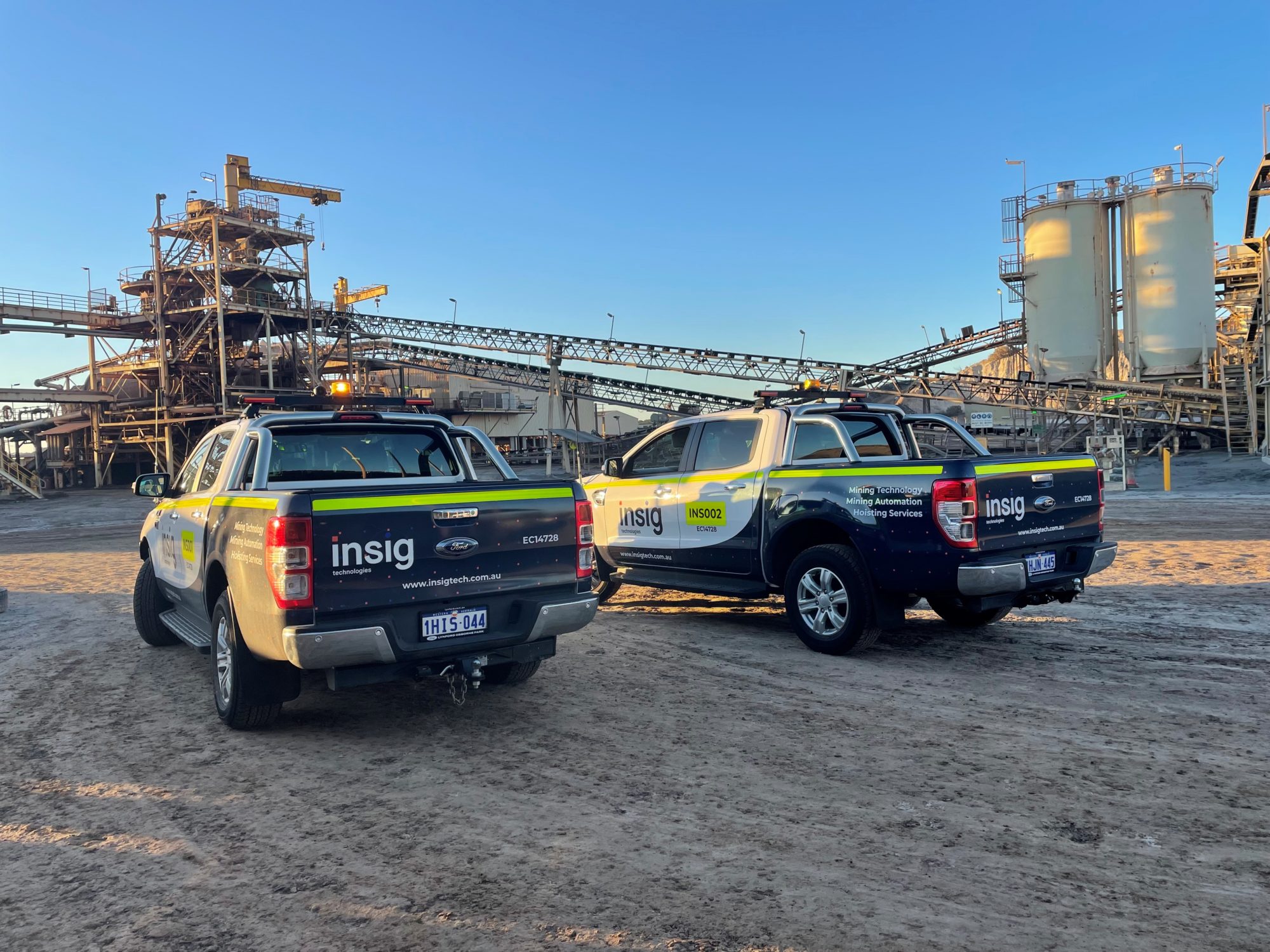Murray & Roberts owns a controlling share in Insig Technologies, a rapidly growing mining centric digitalisation, electrification, interoperability and automation solutions company based out of Perth in Australia. It assists its clients – both Murray & Roberts mining platform companies, their mining clients and other miners, to produce customised, fit-for-purpose mining solutions, and in addition provides specialised electrical and control systems expertise. Insig manages the technology that is changing the face of mining, including underground communications, remote monitoring of equipment, digitisation and the interpretation of real-time data to drive operational efficiencies. It offers services such as data analytics and machine learning capabilities to support deep, real-time insights, predictions and recommendations. Its team of specialists provide digital services comprising life-of-mine (including design), systems and processes to support operations and mining services.
In discussion with IM for a detailed insight into its capabilities were Insig Chief Technology Officer, Giacomo Alampi; Toran Filippi – Manager Operations Technology; Peter Ellery, Growth Executive and Brett Hartmann – Manager Digital & Technology at Murray & Roberts.
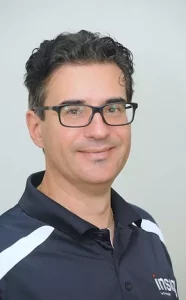
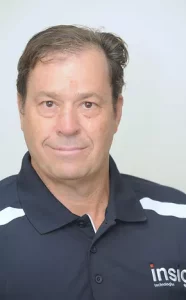
Insig’s Peter Ellery, Growth Executive & , Giacomo Alampi, Chief Technology Officer
Q Is being OEM-agnostic a major advantage in the market in that you can develop interoperable solutions for any type of mobile machine or fixed installation?
We believe interoperability is the foundation to building a digital mine – one only has to learn from other industries’ digital journeys, for example the manufacturing industry’s journey toward 4.0. Our aspiration is to help all our clients, regardless of what OEM equipment or plant they utilise, to build ‘smart’ mines so the industry as a whole can benefit from technology advances. Few organisations have equipment from just one OEM supplier – this could be due to a combination of strategic reasons, a preferred supplier not selling the specific equipment type or their offering not being as competitive as the one from a different supplier both from a technical perspective or from a commercial perspective. Plus, during the life of a mine, operators often transition some equipment out and others in. Added to that you may have an owner operator fleet working together with a contractor fleet, such as where the operator fleet is carrying out production mining and the contractor is responsible for mine development. Another factor contributing to multiple equipment OEM use is the consideration of lead times. Contractors are sometimes forced to purchase what is available governed by their timeline – contract start date and when the equipment is required on the ground. In addition, most OEMs do not have industry leading equipment across all areas of mining requirements including loaders, trucks and drills – normally they only stand out in one or two key mining functions. Added to this, the top three underground OEMs, namely Caterpillar, Epiroc and Sandvik do not produce mine service and support equipment such as charging and utility machines so ultimately, most mine sites will inevitably end up with multiple equipment manufacturers.
Being OEM agnostic is one of our biggest advantages. As equipment manufacturers only provide technology solutions for their own equipment platforms, each solution creates minesite data silos resulting in mining companies trying to use and/or integrate several expensive systems. For fixed equipment, due to the high level of standardisation in control systems, interoperability is much more mature.
Q What synergies are there between Insig and M&R in terms of what you can bring to their global mining customer offering?
Together Murray & Roberts together with Insig Technologies offer the complete PPT triangle (People, Process and Technology), which are widely recognised as the most important ingredients to a successful digital integration. Insig has the capabilities to integrate existing digital solutions or build new agnostic digital solutions, whilst Murray & Roberts provides the People and Process or ‘the knowhow’ to maximise the value of the technology. Collectively, Murray & Roberts plus Insig have the capability of not only building the mines of the future but can also be trusted to manage and operate these new mining environments effectively. It is also bringing about new ways of working together – including potential lean Six Sigma and management consulting type capabilities around mining change management. Overall, digitalisation in mining requires business change as well as bringing a technology solution. There are advantages of the joint approach throughout the lifecycle of a mining contract – Insig can support M&R’s capabilities right from the tender stage all the way through to deployment and during the contract. Most miners today want to see what the latest capabilities are in the digital space. The relationship with M&R also provides Insig with a great opportunity to test technology in the field. Insig can come up with technology advances and then trial them at real operations before marketing them – that’s pretty unique. We would also stress the ability of collaboration to design new digital processes together. Many mining companies have seen digitalisation failures where they have just bought technology but didn’t understand how to implement the process changes to make it possible to leverage the new technology potential. Insig’s technologies are already being applied across the whole Murray & Roberts mining platform, which includes M&R Cementation in South Africa, RUC Cementation Mining and Cementation Americas. There are also opportunities with other M&R companies such as Terra Nova Technologies (TNT) a global leader in conveying and material handling systems solutions.
Insig’s technologies are already being applied across the whole Murray & Roberts mining platform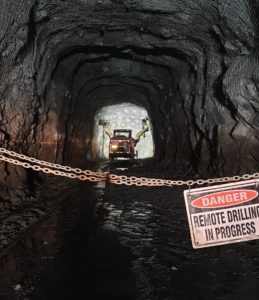
Q What is your Genesis Digital Mine offering and what does it offer to the market? Plus you have partnerships with other suppliers including MineARC and Ampcontrol – what is the thinking there?
Genesis is a good summary of our complete digital mining model – which we shorten to DMM. It incorporates all of the tools we have in that ‘box.’ Those tools can be developed and used individually, or they can be combined for a higher level of operability and a higher level of insight, and that’s where at Murray & Roberts we believe the value is. Mines can go out today and buy a system, but those off the shelf systems are rarely integrated in a way that allows them to capture the full value chain. Genesis represents Murray & Roberts and Insig Technologies’ vision for mining where we have a completely interoperable mining environment, and all the operating data is being collected and augmented to provide the necessary insights to effectively and efficiently manage the mining operation. The digital solutions that Murray & Roberts and Insig Technologies are developing, whilst adding value as standalone products, come together within the Genesis Digital Mine model to deliver a higher level of value through the higher level of operational insights. So in summary, the Genesis Digital Mining model is a fully interoperable digital mining model which will deliver higher value from higher levels of insights. At a detailed level, Genesis is a leading-edge platform for mine control. Genesis has a modular design, leveraging IIOT technologies that are fully integrated with condition monitoring, maintenance scheduling, execution control, reliability, asset management and connected to the reporting platform to provide a full view of the mine. The main differentiator for Insig is its ability to integrate geospatial, time series and transactional data in one location supporting true end-to-end insights across all domains. For example, an operator can start from a spatial view of the mine and understand equipment movements over time. Operational data from the equipment is available to visualise together with the maintenance records. Creating a digital mine requires all data to be integrated vertically, across all ISA95 levels, and horizontally between line of business applications. The Genesis Digital Mine journey has just started and Insig already has deployed its products on a small number of sites. Specifically, the ESG & ventilation, condition monitoring and execution control products.
On partnerships, we partner with a number of organisations where they have an innovative product set that we can include and integrate into our offering. One of the things we are working on at the moment is VOD or Ventilation on Demand – the end goal is to have an entire stack from the motor in the fan through the fan itself and control box all the way to the SCADA system. We would install a complete turnkey system and service it. Obviously, we don’t make motors or fan blades or housings so we have established long term relationships with relevant leading suppliers. We learn from the people who are experts in their particular area, for example control panels, and it is possible because we use open platforms to allow our solution to tie into their software in the same way that we can interface with other equipment at a mining customer site. That said we can also write software and supply our own integration solutions where needed.
Q How does the age of equipment affect interoperability and autonomy possibilities?
For fixed equipment, interoperability standards have been around for years and we are strong there via our control-systems engineering team. But for mobile mining equipment, the depth of interoperable standards is not there although the market is evolving quickly. Looking at the age of equipment, older machines are more mechanical with less use of electronics while newer machines are often much more digitalised. Working with us means you can look at applying autonomy both to legacy machines and the latest machines – this is not something everyone can do. We leverage our experience across multiple clients to be able to do this. Interestingly while the major underground equipment OEMs have been busy buying up underground IoT, digital and analytics companies, our belief is that mining companies generally don’t want to rely on one OEM for a fleet wide solution – they want to make sure they maintain some kind of competitive tension. Plus, a lot of these systems are focussed on machine condition monitoring and tracking – it doesn’t equate to a full autonomous mixed fleet solution that also gives you these capabilities. We can add a lot of value by developing and supplying a vendor independent, comprehensive mixed fleet autonomous capable offering that also offers predictive maintenance and the rest. That also works for M&R as they won’t be using just one OEM across their operations. Also, most operators want to own their data – OEMs often dictate to a degree what data they share with the customer – it might just be in a summary report form that you pay for, you may not get to see the actual data. Insig brings interoperability and full visibility of your data from multiple OEM – plus we do this for Tier 2 and Tier 3 miners. The Tier 1 miners can typically commit huge investments to some of the OEM locked-in solutions for large fleets of one brand but other mines with smaller mixed fleets and Tier 1 mines with mixed fleets and legacy machines need other options.
Insig has grown tenfold in 2020/2021 alone so is one of the fastest growing companies in the mining digitalisation & automation space
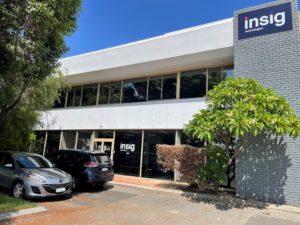
Q Would you describe Insig as a future mining technology solutions developer, provider, integrator or all of these?
Yes all of these. Insig has all the right credentials in that we can integrate existing digital solutions, we have inhouse IT software development capability to build new agnostic solutions but we also have the operational technology (OT) capability where we can install, maintain, and assist clients to optimise the value from digital or autonomous solutions. Using our inhouse automation technicians, we can manage and maintain a full digital system whether it’s the communication system, or troubleshoot autonomous underground LHDs. We also have other key expertise areas including electrical engineering – to give you an example, we have a winding and hoisting department that specialises in designing and building electric mining hoists. Overall, we are one of the few companies worldwide that can offer end to end systems integrator capabilities for underground mining.
Q Would you say interoperability remains the biggest challenge in underground automation or is dealing with legacy infrastructure just as problematic? How do you overcome this?
Presently, interoperability and legacy infrastructure are closely related as it often difficult and expensive to upgrade existing infrastructure. Depending on which lens your looking through, this is creating either a financial or technology ceiling that makes it difficult for some mining operations to benefit from already widely proven technologies. We believe that in the future, interoperability offers the greater challenges but also the greatest rewards. For the mining industry to be able to balance society’s growing needs in terms of raw materials as well as sustainability, we as an industry need to implement interoperability and it is probably the biggest challenge both for surface and underground automation. There is a good level of standardisation on protocols and technologies, but to achieve interoperability a lot more is required in defining what the key information exchanges are between different types of equipment. The question about what messages need to be transmitted and when they need to be transmitted is still open and remains a challenge for most operators. Companies like Insig that operate at the junction between pure equipment vendors and system integrators are in the best position to define what is required. Legacy infrastructure is slowly improving, but a better way to overcome a low level of connectivity is to define the message interchange required and the timeliness to deliver each message. There are also a lot of challenges that come with automation. Mine design is at the forefront of this, but also the choice of mining method, stope design and tramming distances all need to factor in equipment automation advantages and disadvantages to extract the best possible value from this type of technology. This is why legacy mines are a difficult proposition with small stopes and short tramming distances that decrease the efficiency gains from automation. Other challenges are mine networks and communications and keeping the supporting infrastructure up to date with changes in production demand and stope locations due to mining sequences. Most operations will commit to one type of automation solution but interoperability is a huge problem if a mine is running machines from multiple OEMs.
Q While you are a specialist in underground mining projects do you also have a surface mining focus and capability?
At this point in time due to our partnership with M&R and the requirements of their underground mining platform we are mainly focussed on the underground mining space. Underground is also the toughest environment for these types of solutions and therefore suits a specialist integrated approach. On the surface the same principles apply with differences mainly in the network and communications backbone. Such is our rate of growth, however, that we are already talking to some surface operators about the potential applicability of our DMM offering. M&R has also publicly stated that growth in the surface contract mining space is part of its roadmap – it already has earthmoving experience through Concor Opencast Mining as an example.
Q Are you finding more demand for fully autonomous versus semi-autonomous remote operation solutions from clients in terms of their mines?
Its really horses for courses, as you find fully autonomous demand in large heading, high throughput and long life mines like some of the larger stoping or caving mines, where there is a lot of movement repetition on the same levels with large LHDs or LHD and truck fleets loading ore passes or crushers and material being hoisted to surface. Then you have the smaller and more dynamic (and usually contractor operated) underground mines, often just utilising declines, which need a bit more flexibility to be able to move infrastructure quicker and easier to new mining levels and as a result tend to use semi-autonomous equipment. These mines are very common in the Kalgoorlie Goldfields as an example. These are open stope, narrow vein, high grade operations.
Shaft sinking and hoisting technologies are a real focus of Insig’s roadmap from design engineering to instrumentation and electrification including designing switch rooms that can be containerised for easy delivery
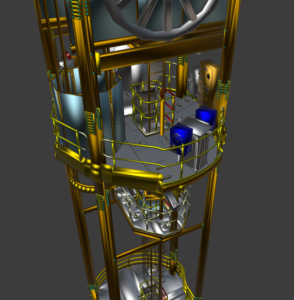
Q Are you also involved in collision avoidance related projects underground for manned machines?
Insig Technologies is involved in projects that involve collision avoidance systems, particularly in South Africa where it is becoming part of the legislative framework. But we are not developing our own solution as there are some very good systems already out there being used that have been built by specialists in that area. We are, however, involved in working with a supplier of one such system to a Murray & Roberts underground mining contract site and are looking at how we can integrate their system data to present it differently to give the users more operational insights. Again, we could act as an end-to-end systems integrator that incorporates their proximity detection/collision avoidance technology. These technologies generate a lot of useful data that can be used for other purposes. The more efficiently you can use data from one system (such as collision avoidance) the easier it is to minimise the number of sensors that have to be on mining equipment while it also reduces the functionality and control requirements within our DMM.
Q Other companies offer autonomy by retrofit for underground machines – how are you distinct at Insig?
They don’t have the breadth of offering that we have with DMM, which not only includes autonomy elements but also the tracking and Predictive Maintenance software as well as the ability to act as an electrical contractor – we can install the panels for example. At the same time, we can also work in partnership with some of these companies to offer a complete solution. Each company brings their expertise and best game to the table. As we have said, we do have gaps – for example we don’t make transmitters and receivers that go on an autonomous machine. We can also help support other systems, even if that be an OEM automation system. That includes optimising other autonomy systems and training people to get the most out of the system and the resulting data.
Q Would you say the main driver of automation is labour saving, safety or productivity?
Safety is probably the main driver for automation, but automation also allows higher productivity as personnel can work from a remote location, without the environmental constraints of being underground. In surface mining, safety is still a big factor, but the productivity advantages of automation probably take a more predominant role. In our experience, there are very few mining companies that approach an automation project purely from a labour saving perspective. The savings are present, but due to the initial capital investments often these operational savings are not significant enough to justify the project risk. Automation in mining had its development roots in safety, enabling machines to be operated remotely to remove operators from hazardous situations. As automation and digitalisation have matured they has continued to drive safety progress, removing people from the mines and enabling machines to be operated remotely or autonomously from the comfort and safety of offices on the surface. Digitalisation has also improved communications which has enabled more smart safety devices and solutions such as people & machine tracking, collision avoidance systems, geofencing and even personal wearable safety devices to monitor individual’s health and safety. Production in many cases has also improved, through enabling machines to operate during traditional non-productivity times such as shift changes or post-blasting, improving utilisation of capital intensive equipment and ultimately driving productivity gains. For mining to become increasingly more sustainable, the industry needs technology and automation brought together under the PPT model we talked about earlier.
Q As underground mines become more autonomous with more use of cameras, do you see an increasing demand for underground LTE/5G type networks versus more traditional approaches and is this something you are already offering?
Underground communication technology has definitely been one of the main constraints in the past, so as digitalisation of underground mines increases, so too will the demand for connectivity and data transmission. There are many different underground communication technologies, and we believe that it isn’t a one size fits all situation. We work with our clients to understand what the current and future needs will be and from this position we assist them to select the most appropriate communication technology, which could include WiFi over fibre optic cables or LTE. For big surface mines, LTE and then 5G is the way to go and the 5G private networks have on the whole been designed for use above ground. Yes, the demand for underground connectivity is increasing significantly due to the demands of automation. But again here it is horses for courses – it is in larger mines that have large headings similar to those in civil tunnelling where we see the first LTE/5G projects being executed, but more traditional approaches are more cost efficient for medium to small underground mines plus in smaller mines where you have issues with a lot of standing water and a moist and corrosive environment. Plus often 5G signals do not propagate well due to reflections in smaller drifts. The two limiting factors of using carrier-based technologies like LTE are the large capital investment required and the difficulty of operating and maintaining the equipment, requiring specialised skills. Insig offers multiple underground communication solutions focusing on digital drift and underground fibre, WiFi & LTE. We are also working on the next big game changer in underground connectivity…watch this space.
Q What role are you playing in helping underground mining transition to electric operations including the use of more battery electric equipment?
Of course this is one of our roadmap focus areas. We are actually looking at how you electrify a mine underground from an engineering point of view – in terms of charging infrastructure etc. But also going back to the hoisting and winding side of things, we are looking at regeneration of power from empty skip hoisting (downward conveyance) into batteries – we have done that and are rolling it out at a new shaft sinking project where you can power the upward conveyance (full skips) movement with the stored battery power. Plus that mine has a planned BEV fleet so there are a lot of opportunities there for new infrastructure approaches. Battery equipment also requires a different approach to machine health monitoring so we are also looking at that.
Q Your role scope and project volume is increasing fast throughout the M&R mining platform and beyond – how are you managing this in terms of specialist staff, global locations etc?
We have a global growth plan working with M&R, aligning our presence with their digital mining growth plans that has a focus on three continents and four major pillars of capability. If anything, our biggest challenge is getting the right skilled people. In 2020/2021, we grew from a 10 person company to over 100 people. Our main Australian workshop is already more than twice the size of our original facility and we intend to open more locations around the world in due course to support our ambitions. Shaft sinking and hoisting technologies are a real focus of our roadmap as well from design engineering to instrumentation and electrification including designing switch rooms that can be containerised for easy delivery. As an example, we are aiming to be the predominant digital technology provider for shaft sinking globally, including with our AR/VR capabilities. And we have a number of significant projects underway that require both our IT and OT abilities. That said & done, we are always open to strategic partnerships with end-user miners and to global mining consultancies to deploy our Genesis Digital Mining Model.











